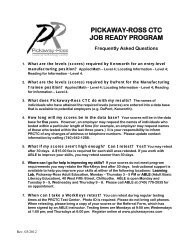Commons
Conceptual Physics - elearning-phys
Conceptual Physics - elearning-phys
- No tags were found...
You also want an ePaper? Increase the reach of your titles
YUMPU automatically turns print PDFs into web optimized ePapers that Google loves.
8 As discussed in question 4, there are two types of curvedmirrors, concave and convex. Make a list of all the possible combinationsof types of images (virtual or real) with types of mirrors(concave and convex). (Not all of the four combinations are physicallypossible.) Now for each one, use ray diagrams to determinewhether increasing the distance of the object from the mirror leadsto an increase or a decrease in the distance of the image from themirror.Draw BIG ray diagrams! Each diagram should use up about half apage of paper.Some tips: To draw a ray diagram, you need two rays. For one ofthese, pick the ray that comes straight along the mirror’s axis, sinceits reflection is easy to draw. After you draw the two rays and locatethe image for the original object position, pick a new object positionthat results in the same type of image, and start a new ray diagram,in a different color of pen, right on top of the first one. For the twonew rays, pick the ones that just happen to hit the mirror at thesame two places; this makes it much easier to get the result rightwithout depending on extreme accuracy in your ability to draw thereflected rays.9 In figure x in on page 152, only the image of my forehead waslocated by drawing rays. Either photocopy the figure or downloadthe book and print out the relevant page. On this copy of the figure,make a new set of rays coming from my chin, and locate its image.To make it easier to judge the angles accurately, draw rays from thechin that happen to hit the mirror at the same points where the tworays from the forehead were shown hitting it. By comparing thelocations of the chin’s image and the forehead’s image, verify thatthe image is actually upside-down, as shown in the original figure.10 If the user of an astronomical telescope moves her headcloser to or farther away from the image she is looking at, doesthe magnification change? Does the angular magnification change?Explain. (For simplicity, assume that no eyepiece is being used.)11 Here’s a game my kids like to play. I sit next to a sunnywindow, and the sun reflects from the glass on my watch, making adisk of light on the wall or floor, which they pretend to chase as Imove it around. Is the spot a disk because that’s the shape of thesun, or because it’s the shape of my watch? In other words, woulda square watch make a square spot, or do we just have a circularimage of the circular sun, which will be circular no matter what?12 A Global Positioning System (GPS) receiver is a device thatlets you figure out where you are by measuring the time for radio160 Chapter 7 The Ray Model of Light



